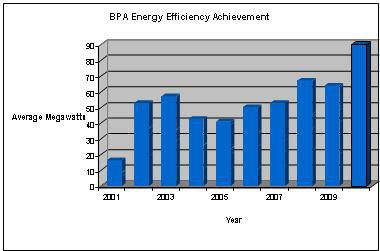forum
library
tutorial
contact

BPA Accelerates Delivery of $35 Million
to Utilities for Energy Efficiency
by Staff
Transmission & Distribution World, June 20, 2011
|
the film forum library tutorial contact |

|
BPA Accelerates Delivery of $35 Million
by Staff
|
 Northwest public utilities saved more energy last year than ever before, freeing up enough electricity to power 65,700 more homes by not using it in the first place. The Bonneville Power Administration is building on that success by dedicating $35 million this year to public utility energy efficiency programs that was originally scheduled to be delivered in the coming years.
Northwest public utilities saved more energy last year than ever before, freeing up enough electricity to power 65,700 more homes by not using it in the first place. The Bonneville Power Administration is building on that success by dedicating $35 million this year to public utility energy efficiency programs that was originally scheduled to be delivered in the coming years.
The funding will flow to BPA's partner utilities for energy efficient projects and technologies that range from retrofitting neighborhood grocery store shelves with power-saving LED lighting to upgrading old and inefficient irrigation pumps. BPA recognizes energy efficiency as the cleanest and most affordable source of new electricity, which also saves power customers money. Last year's record achievement, for example, reduced Northwest power bills by more than $57 million. More rapidly funding these efforts now will be less expensive than it would be in the future, which will produce savings for BPA and its customers.
Last year's savings of nearly 90 average megawatts was the most ever by BPA's utility customers, beating BPA's goal for the year of 80 aMW at less cost than expected. It came as the Northwest already leads the nation in energy efficiency, supplying 12 percent of its electricity needs in 2009 through energy savings compared to just 1 percent for the United States overall. This year, the accelerated funding will assist BPA's utility customers to exceed the agency's current 99 aMW target.
The Northwest Power and Conservation Council's Sixth Power Plan adopted last year calls for meeting 85 percent of the region's new demand for electricity over the next 20 years with energy efficiency. The aggressive goals require a rapid ramp up. BPA and its partners must save nearly twice as much energy over this five year period as they did in the previous five years.
BPA-sponsored programs enact simple changes that make saving energy easy. For example:
bluefish received the following group email from BPA's Steve Weiss, Constituent Account Executive for Public Interest GroupsI want to clarify an aspect of the press release below based on feedback I am receiving. As some of you may have heard in other forums and discussed in the press release, the $35 million is not new funding. Instead it is money being moved forward from future years. Much of this money is being used for low-cost measures such as lighting-measures that have costs quite a bit below BPA's projected average energy efficiency (EE) costs. Thus Bonneville believes that this $35 million will achieve savings that had been projected, when budgets were originally proposed, to cost about $47 million. What is technically happening is that we can get more aMW this year (FY11) than we originally expected (holding all other things constant - including an amount assumed for utility self-funding based on about 25% of the target). The average cost that we assumed for this year on a $/aMW basis is lower than it is in the next three years, by $12m ($47m - $35m).
Therefore BPA will likely propose in future Integrated Program Review (IPR) decisions to reduce its out-year EE budget by up to $47 million, not $35 million. (The IPR is the public process BPA conducts in the period before each two-year rate case to set program budget levels.) At this time, that future budget has not been subject to that public review, so it is not set in stone. It is important to note that the ultimate controlling factor for the EE budget floor is having enough funding to meet the public utilities' share of the Council's targets. At issue may be whether BPA should go beyond that target if savings are coming in at a lower cost than expected.
learn more on topics covered in the film
see the video
read the script
learn the songs
discussion forum
